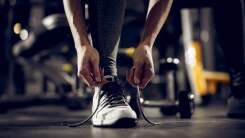It’s Fine, You Can Lift in Running Shoes

Maybe this is just me being Extremely Online, but whenever I see someone squatting in running shoes, a comment section goes off in my head. “Ditch the shoes!” “You’ll hurt yourself!” “You don’t want cushions under your feet when there’s a heavy bar on your back!”
There’s some truth behind those knee-jerk reactions; when squatting (or deadlifting), I do not personally wear running shoes nor would I recommend them. But the importance of your choice of shoes is hugely overblown. You aren’t going to injure yourself or kill your gains by squatting in sneakers.
Why people say you shouldn’t squat in sneakers
Why is this questionable advice so pervasive? I blame internet form-check culture. People who have just learned to squat themselves aren’t in a position to diagnose mobility issues, or on the flip side to reassure new lifters that they’re basically doing fine and just need more practice. But they can see that you are wearing New Balances, so that’s what they pick on first.
The idea is that running shoes and other soft sneakers put a squishy layer of foam under your feet. When you’re running, that’s great; it absorbs impact and helps to return some energy to your foot as you push off. But when you’re squatting or deadlifting, you’ll benefit more from a solid footing.
I can agree with the sneaker-haters that your best options for squatting are either firm shoes (with no squish at all) or going without shoes. I’d rank your options like this:
-
Weightlifting shoes, like Nike Romaleos or Reebok Legacy Lifters, which have an elevated heel and a very firm sole. These are best if you need or prefer an elevated heel to keep good body positioning while you squat. They’re pricey though, and if you have good ankle mobility, you may not benefit much from the heel.
-
Shoes with a firm, flat sole, like Converse Chuck Taylors or Vans Old Skools. These are good all-around gym shoes, and you can deadlift in them, too.
-
No shoes at all. Most gyms frown on true barefoot training but it’s usually fine to slip off your shoes and lift in socks.
I have a more detailed guide here to choosing the right shoes to lift in. If you want to buy shoes specifically for lifting, consider those options. But what if you’re new to the gym and all you have is sneakers?
Come on, sneakers aren’t going to kill you
When the sneaker-haters start making scary claims, saying you’ll hurt yourself or that you can’t possibly lift heavy in squishy shoes, they really don’t have a firm sole to stand on.
There aren’t any studies that attribute a higher injury rate to sneaker-wearers than to lifters who wear other footwear. Any claims that you’ll get hurt in sneakers are pretty much guaranteed to be made up. People love to scare each other about “dangerous” exercises and practices in the gym, evidence be damned.
I’ll admit that when I squat in sneakers, I don’t feel as stable. But I have squatted in sneakers, and the squats go fine. Look around your local gym; you’ll see plenty of people in suboptimal footwear.
Earlier this year I participated in a competition where people executed a variety of strange and heavy lifts. Toward the end, a few folks were attempting one-legged lifts, and commented that it was hard to do these in sneakers. I looked around and realized that most of the competitors had been wearing sneakers all day. And probably trained in them too. These were folks who had been putting up serious poundages! Until they took on a particularly balance-focused task, their choice of footwear hadn’t stood in their way at all.
Lifting in sneakers is the same kind of “not ideal, but you’ll be fine” situation as squatting without a belt, or running on a sunny day without sunglasses. So, should you squat in sneakers? Eh, they’re not your best option. But if they’re what you have for now, you’ll be fine.



